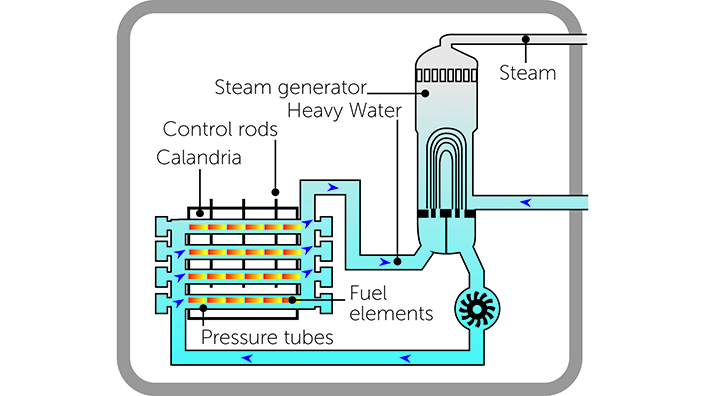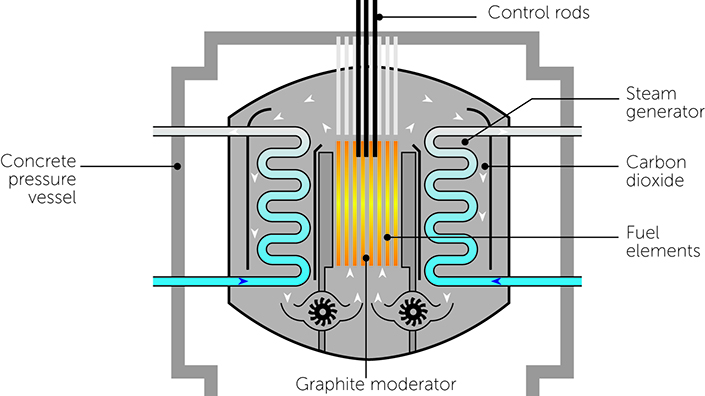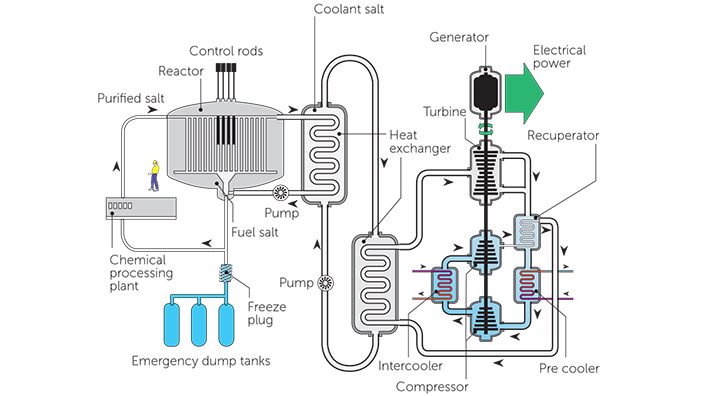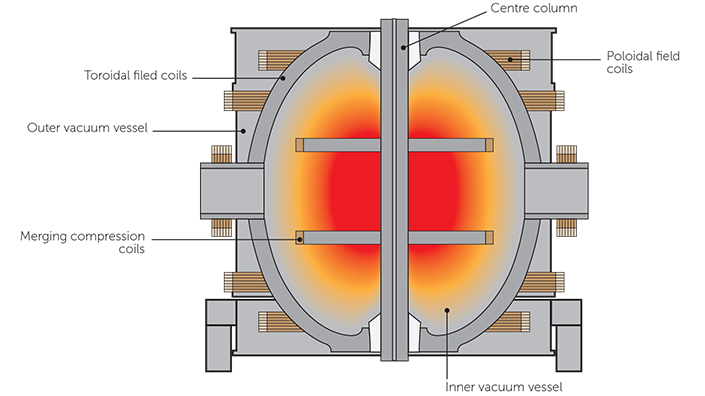Read part one, "Power Play: The small solution to the world's big nuclear energy problem".
Read part two, "Power Play: The race to build the first small modular reactor".
Light-water reactors: The Toyotas of fission

All infographics by Paul Wootton
Light-water reactors (LWRs) are the Toyotas of the nuclear fission industry. Tried, tested and reliable, they make up 80% of large-scale nuclear power plants around the world. Of the 55-odd reactors under construction, 49 are based on this technology.
LWRs rely on fissile chain reactions, with elements such as uranium and plutonium split apart to create heat, boil water, generate steam and turn turbines. Some compare it to boiling a kettle, but with nuclear reactions instead of electricity. Fuel rods and complex networks of isolated water pipes are used. The water acts as both a coolant and a moderator for the nuclear reactions.
LWRs include pressurised water reactors (PWRs) such as the UK’s Hinkley Point C and boiling water reactors (BWRs) like Japan’s Fukushima Daiichi power plant.
Rolls-Royce, which is leading a British consortium to research SMRs and to shrink the size of power plants, sees these existing technologies as the short-term future of nuclear power. “Rolls-Royce is the only UK firm with experience of designing, operating and maintaining this scale of reactors and has done for 50 years, so we know the technology well,” says the company’s David Orr.
“With significant time pressures coming from our rising energy needs and climate change, our approach has been on providing fast, commercially investible electricity. It’s important that new reactor types are developed but we know this technology inside out and it can do the job now, not in 15 years’ time.”
Heavy-water reactors: Muscle machines

Heavy-water reactors (HWRs) are similar to LWRs except, predictably, they use heavy water instead of light water to cool and moderate the nuclear reactions. Heavy water contains a larger than normal amount of the hydrogen isotope deuterium, which creates extra mass and gives the water different physical and chemical properties. There are four HWRs under construction and many of those already operating can be found in Canada.
Leeds University’s Giorgio Locatelli, who teaches at the school of civil engineering, says the main advantage of HWRs is that they don’t necessarily require enriched uranium and can operate on natural uranium. This means that to produce the fuel there is no need for enrichment plants, which are expensive and can also be used to create weapons. Locatelli says HWRs tend to be more expensive and larger than LWRs. Modern LWRs and HWRs are third-generation nuclear energy systems.
Gas-cooled reactors: Evaporating enthusiasm

The UK and France experimented with gas-cooled reactors (GCRs) but they are falling out of favour and are being overtaken by other technologies, explains Locatelli. Typically, GCRs use graphite to moderate the nuclear reactions and carbon dioxide as a coolant.
But developments in SMRs may just breathe some new life into this concept. According to a report from the International Atomic Energy Agency, research and design into more modern high-temperature gas-cooled reactors is taking place across the globe, in countries including China, Japan and South Africa. The agency reports that there is one such reactor being built at the moment.
Molten-salt reactor: Shaking things up

Enter the fourth-generation nuclear energy technologies. The molten-salt reactor (MSR) is one of six systems being explored as part of the next wave of power plants and SMRs.
In theory, these new systems will be safer, more productive and capable of using the waste made by previous generation plants and of making hydrogen for other uses.
The technology attracting most bets is the MSR. The idea to use salt instead of water has been around since the 1960s and is attractive because of its simpler design and potential safety. There is no chance of a steam pressure explosion (because there is no steam) and there’s the ability to better control nuclear reactions with salt heated beyond its melting point and turned into a fluid.
MSRs don’t have fuel rods – the fuel is dissolved within the liquid salt coolant. They can be refilled while operating and produce waste that decays (relatively) faster. One of the major problems with using molten salt, however, is figuring out how to handle the corrosion it causes.
“The key to MSRs is their intrinsic safety, where there would be no radioactive leakage beyond the nuclear safety zone in any accident event,” explains Stephen Haighton, CEO of Moltex Energy, which is developing this technology. “The elimination of the hazard, rather than the containment of the hazard, means that power plants containing MSRs can be built at the same sort of cost as combined-cycle gas turbine plants, and cheaper than coal, plus they can be sited in similar locations to fossil-fuel plants. This offers up the possibility of a zero-carbon, distributed energy production network at no increased cost to the current infrastructure.
“The first power plant variant also consumes today’s stocks of spent nuclear fuel, so reducing this toxic liability, and it can vary its output, so offering a partner to renewable strategies because it can match the intermittency of this type of power source.”
The other five systems include: gas-cooled fast reactors, lead-cooled fast reactors, supercritical water-cooled reactors, sodium-cooled fast reactors and very high-temperature reactors.
Nuclear fusion: The ultimate prize

Fusion is the power source of the Sun and stars. If reproduced on Earth, it will give humans what some academics describe as the “perfect way to make energy”.
“In the tremendous heat and gravity at the core of these stellar bodies, hydrogen nuclei collide, fuse into heavier helium atoms and release tremendous amounts of energy,” is how the process is explained on the website of the world’s biggest nuclear fusion experiment, ITER, being set up in France. In other words, where fission is the act of splitting atoms, fusion is the act of smashing them together. The difficult part is recreating on Earth what happens in the Sun.
It’s generally accepted that the two best ways for humans to create fusion is by using either magnets (tokamaks) or lasers. They present different challenges.
The physics of how to create plasma burn, within which particles can collide, is fairly well understood. But how to reach the required temperatures (100m degrees Celsius plus), confine the unstable plasma and maintain it long enough to make the process worthwhile are all problems still being tackled. The greatest paradox is that currently it takes more electricity to run a fusion machine than the amount of energy this machine can produce.
Content published by Professional Engineering does not necessarily represent the views of the Institution of Mechanical Engineers.